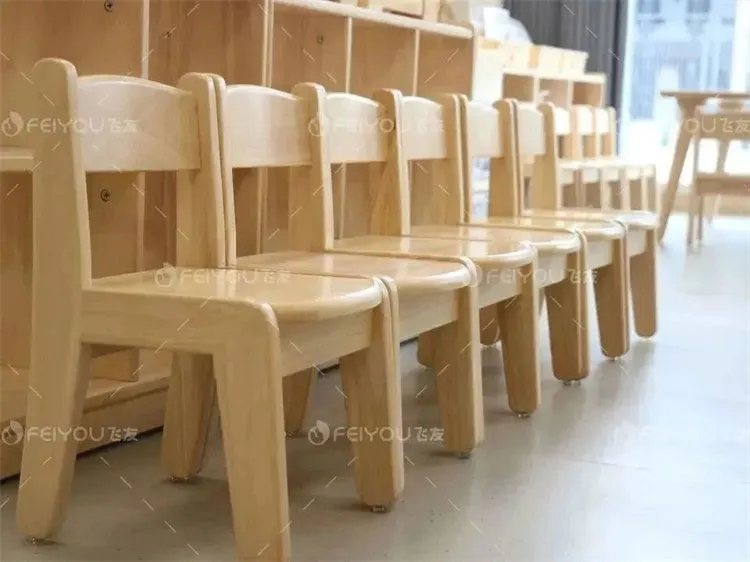The thoughtful selection and design of kindergarten furniture are pivotal in enhancing children's sensory development and overall engagement within learning environments. By choosing furniture that offers a variety of sensory stimuli—such as different textures, colors, and adjustable features—educators can create inviting spaces that encourage exploration.
For example, the integration of soft seating options that promote movement allows children to interact with their surroundings dynamically. Moreover, flexible furniture configurations support both individual and group activities, fostering social interaction and collaboration among peers. These elements collectively contribute to a rich educational experience, where creativity flourishes and curiosity is nurtured through playful engagement with thoughtfully designed furniture.

The Impact of Thoughtful Kindergarten Furniture on Sensory Exploration
By incorporating diverse textures, colors, and shapes, furniture can stimulate children's tactile and visual senses, fostering an environment rich in discovery.
For instance, tables with varying heights can cater to different activities, allowing children to explore their surroundings from multiple perspectives. Likewise, seating that encourages movement—such as wobble stools or cushions—can promote engagement and active participation.
|
Furniture Type
|
Sensory Benefit
|
Example Usage
|
|
Textured Panels
|
Tactile exploration
|
Wall-mounted play areas
|
|
Colorful Rugs
|
Visual stimulation
|
Define play zones
|
|
Adjustable Tables
|
Height variety for activities
|
Art projects, group tasks
|
|
Movement-Friendly Seats
|
Encouraging active engagement
|
Group discussions, storytelling sessions
|
By designing environments with these considerations in mind, educators can cultivate an engaging space where sensory development thrives and curiosity is sparked.
Fostering Engagement: How Interactive Environments Shape Young Minds
Interactive environments play a vital role in early childhood education by encouraging exploration and engagement. When kindergarten furniture is designed with interactivity in mind, children are naturally drawn to participate.
For instance, activity tables with varied textures and colors can stimulate tactile engagement, while movable seating encourages collaboration among peers. This kind of setup not only promotes sensory exploration but also nurtures social skills through group activities.
Moreover, incorporating elements like soft play areas or creative display boards ignites creativity, allowing children to express themselves freely. As children navigate these thoughtfully arranged spaces, they develop a sense of curiosity and belonging, which is essential for their overall growth and learning experience.
Designing Furniture that Nurtures Creativity in Kindergarten Settings
Creating an environment that fosters creativity in kindergarten requires careful attention to furniture design. Pieces should be adaptable, allowing for various configurations that promote collaboration and imaginative play.
For instance, modular seating can be rearranged to accommodate different activities, encouraging children to express themselves freely. Additionally, using soft textures and vibrant colors can stimulate sensory experiences, making the space more inviting and engaging. The inclusion of interactive elements, such as chalkboards or movable parts, provides hands-on opportunities for exploration.
By integrating these thoughtful design principles, educators can enhance the creative potential of young learners, making furniture a key player in their developmental journey.
Enhancing Sensory Development Through Innovative Kindergarten Configurations
Thoughtful design ultimately cultivates an atmosphere where sensory exploration thrives, setting a strong foundation for lifelong learning.
For example, soft seating areas with tactile cushions encourage children to explore their sense of touch while promoting comfort and relaxation.
Additionally, movable furniture pieces enable children to reconfigure their play spaces according to their needs, fostering both autonomy and collaboration. Selecting furniture that supports interactive learning encourages children to connect with their peers, enhancing social skills as they experiment in an environment rich with opportunities for discovery.

Creating Stimulating Learning Environments with Purposeful Furniture Choices
Thoughtfully selected furniture in kindergarten settings plays a significant role in fostering stimulating learning environments for young children. By incorporating pieces that promote movement and interaction, educators can create spaces that invite exploration and engagement.
For instance, flexible seating options like bean bags or cushions allow for comfort and mobility, encouraging kids to rearrange their surroundings based on their activities. Additionally, multi-functional furniture such as tables with built-in storage can minimize clutter while providing accessible resources, further enhancing sensory experiences. Colorful and creatively designed furniture not only captures children's attention but also supports imaginative play, allowing them to invent new games and scenarios.
Overall, strategic furniture choices lay the foundation for an interactive atmosphere that nurtures curiosity and creativity among young learners.
Promoting Sensory Play: The Role of Furniture in Early Childhood Education
Thoughtfully crafted pieces, such as tables with varied textures or seating that encourages movement, can stimulate tactile exploration and creative thinking. For example, movable chairs and collaborative workstations allow children to interact with one another, fostering social skills while they engage in sensory-rich activities.
Furthermore, integrating elements like soft seating or quiet corners creates inviting spaces for imaginative play. This encourages children to explore their surroundings freely and enhances their sensory development.
Ultimately, the right furniture can transform a classroom into an interactive environment that nurtures curiosity and creativity, vital components of early education.

Conclusion
In conclusion, the thoughtful design of kindergarten furniture significantly contributes to sensory development and creative engagement among young children. By creating environments that incorporate varied textures, colors, and interactive elements, educators can cultivate curiosity and exploration.
Act now!
Contact our customer service team for free shopping guides and the latest product catalogs!